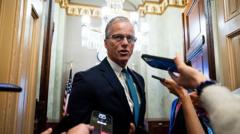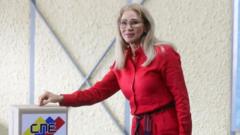During the ongoing papal conclave, 133 cardinals gather in the Sistine Chapel to elect a successor to Pope Francis. As they navigate this complex process, the church faces both financial strains and pressing calls for progressive change.**
Papal Conclave Continues as Cardinals Seek New Leadership Amid Uncertain Times**

Papal Conclave Continues as Cardinals Seek New Leadership Amid Uncertain Times**
The Vatican conclave, tasked with electing the next pope, enters its second day, highlighting the diverse challenges faced by the Catholic Church today.**
The conclave responsible for selecting the next pope resumed on Thursday morning, marking its second day of deliberation. The initial voting session on Wednesday failed to produce a consensus among the 133 cardinals, who remain sequestered in the Sistine Chapel in complete secrecy and without any contact to the outside world.
After the passing of Pope Francis in April, the Catholic Church enters a defining moment as it seeks a new leader for its 1.4 billion adherents. The electoral process for the papacy is not only historic but strategic, with a two-thirds majority needed for a new pope to be chosen. This marks the first conclave in over a decade and comes at a time when the church is grappling with financial challenges and ongoing discussions regarding past scandals.
The current conclave is unique; its composition includes many cardinals appointed by Francis, resulting in a diverse mix of viewpoints and political alignments. The dynamics may lead to a more complex selection process, particularly as the church remains divided between conservative and progressive factions.
Voting will take place throughout the day, with four rounds scheduled until a majority is achieved. The results of each voting session are symbolized by smoke signals emitted from the Sistine Chapel's chimney – black smoke indicates no decision, while white smoke announces a new pope.
Possible contenders include Cardinal Pietro Parolin of Italy, seen as a close ally to Francis, and Cardinal Luis Antonio Tagle from the Philippines, where the church's following is growing. The outcome of this election could serve as a referendum on the vision of change instilled by Pope Francis, especially as cardinals weigh whether to pursue inclusion or revert to conservative traditions.
The conclave also abides by strict confidentiality rules, with cardinals forbidden from using electronic devices or communicating about the voting process. The selection of a new pope could take several days or potentially longer as the voting unfolds. Each ballot is cast with a handwritten note under the phrase “Eligo in Summum Pontificem,” as the cardinals seek to reach consensus on their next leader.
As the process continues, the evolving narratives around the church and its future remain closely watched by the millions who look to the Vatican for guidance and hope.
After the passing of Pope Francis in April, the Catholic Church enters a defining moment as it seeks a new leader for its 1.4 billion adherents. The electoral process for the papacy is not only historic but strategic, with a two-thirds majority needed for a new pope to be chosen. This marks the first conclave in over a decade and comes at a time when the church is grappling with financial challenges and ongoing discussions regarding past scandals.
The current conclave is unique; its composition includes many cardinals appointed by Francis, resulting in a diverse mix of viewpoints and political alignments. The dynamics may lead to a more complex selection process, particularly as the church remains divided between conservative and progressive factions.
Voting will take place throughout the day, with four rounds scheduled until a majority is achieved. The results of each voting session are symbolized by smoke signals emitted from the Sistine Chapel's chimney – black smoke indicates no decision, while white smoke announces a new pope.
Possible contenders include Cardinal Pietro Parolin of Italy, seen as a close ally to Francis, and Cardinal Luis Antonio Tagle from the Philippines, where the church's following is growing. The outcome of this election could serve as a referendum on the vision of change instilled by Pope Francis, especially as cardinals weigh whether to pursue inclusion or revert to conservative traditions.
The conclave also abides by strict confidentiality rules, with cardinals forbidden from using electronic devices or communicating about the voting process. The selection of a new pope could take several days or potentially longer as the voting unfolds. Each ballot is cast with a handwritten note under the phrase “Eligo in Summum Pontificem,” as the cardinals seek to reach consensus on their next leader.
As the process continues, the evolving narratives around the church and its future remain closely watched by the millions who look to the Vatican for guidance and hope.






















